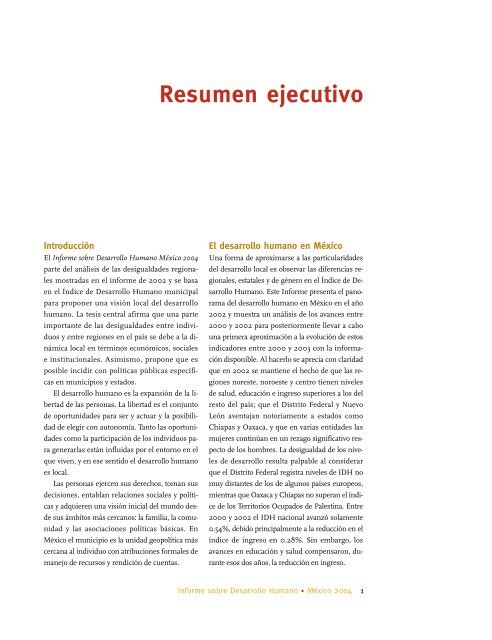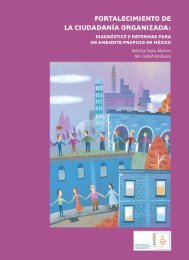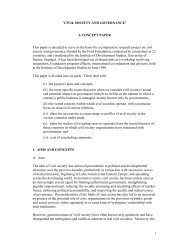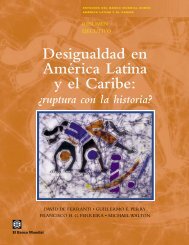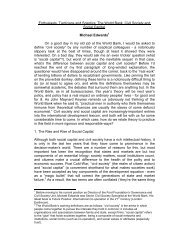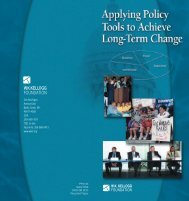Resumen Ejecutivo - Programa de las Naciones Unidas para el ...
Resumen Ejecutivo - Programa de las Naciones Unidas para el ...
Resumen Ejecutivo - Programa de las Naciones Unidas para el ...
Create successful ePaper yourself
Turn your PDF publications into a flip-book with our unique Google optimized e-Paper software.
<strong>Resumen</strong> ejecutivo<br />
Introducción<br />
El Informe sobre Desarrollo Humano México 2004<br />
parte <strong>de</strong>l análisis <strong>de</strong> <strong>las</strong> <strong>de</strong>sigualda<strong>de</strong>s regionales<br />
mostradas en <strong>el</strong> informe <strong>de</strong> 2002 y se basa<br />
en <strong>el</strong> Índice <strong>de</strong> Desarrollo Humano municipal<br />
<strong>para</strong> proponer una visión local <strong>de</strong>l <strong>de</strong>sarrollo<br />
humano. La tesis central afirma que una parte<br />
importante <strong>de</strong> <strong>las</strong> <strong>de</strong>sigualda<strong>de</strong>s entre individuos<br />
y entre regiones en <strong>el</strong> país se <strong>de</strong>be a la dinámica<br />
local en términos económicos, sociales<br />
e institucionales. Asimismo, propone que es<br />
posible incidir con políticas públicas específicas<br />
en municipios y estados.<br />
El <strong>de</strong>sarrollo humano es la expansión <strong>de</strong> la libertad<br />
<strong>de</strong> <strong>las</strong> personas. La libertad es <strong>el</strong> conjunto<br />
<strong>de</strong> oportunida<strong>de</strong>s <strong>para</strong> ser y actuar y la posibilidad<br />
<strong>de</strong> <strong>el</strong>egir con autonomía. Tanto <strong>las</strong> oportunida<strong>de</strong>s<br />
como la participación <strong>de</strong> los individuos <strong>para</strong><br />
generar<strong>las</strong> están influidas por <strong>el</strong> entorno en <strong>el</strong><br />
que viven, y en ese sentido <strong>el</strong> <strong>de</strong>sarrollo humano<br />
es local.<br />
Las personas ejercen sus <strong>de</strong>rechos, toman sus<br />
<strong>de</strong>cisiones, entablan r<strong>el</strong>aciones sociales y políticas<br />
y adquieren una visión inicial <strong>de</strong>l mundo <strong>de</strong>s<strong>de</strong><br />
sus ámbitos más cercanos: la familia, la comunidad<br />
y <strong>las</strong> asociaciones políticas básicas. En<br />
México <strong>el</strong> municipio es la unidad geopolítica más<br />
cercana al individuo con atribuciones formales <strong>de</strong><br />
manejo <strong>de</strong> recursos y rendición <strong>de</strong> cuentas.<br />
El <strong>de</strong>sarrollo humano en México<br />
Una forma <strong>de</strong> aproximarse a <strong>las</strong> particularida<strong>de</strong>s<br />
<strong>de</strong>l <strong>de</strong>sarrollo local es observar <strong>las</strong> diferencias regionales,<br />
estatales y <strong>de</strong> género en <strong>el</strong> Índice <strong>de</strong> Desarrollo<br />
Humano. Este Informe presenta <strong>el</strong> panorama<br />
<strong>de</strong>l <strong>de</strong>sarrollo humano en México en <strong>el</strong> año<br />
2002 y muestra un análisis <strong>de</strong> los avances entre<br />
2000 y 2002 <strong>para</strong> posteriormente llevar a cabo<br />
una primera aproximación a la evolución <strong>de</strong> estos<br />
indicadores entre 2000 y 2003 con la información<br />
disponible. Al hacerlo se aprecia con claridad<br />
que en 2002 se mantiene <strong>el</strong> hecho <strong>de</strong> que <strong>las</strong> regiones<br />
noreste, noroeste y centro tienen niv<strong>el</strong>es<br />
<strong>de</strong> salud, educación e ingreso superiores a los <strong>de</strong>l<br />
resto <strong>de</strong>l país; que <strong>el</strong> Distrito Fe<strong>de</strong>ral y Nuevo<br />
León aventajan notoriamente a estados como<br />
Chiapas y Oaxaca, y que en varias entida<strong>de</strong>s <strong>las</strong><br />
mujeres continúan en un rezago significativo respecto<br />
<strong>de</strong> los hombres. La <strong>de</strong>sigualdad <strong>de</strong> los niv<strong>el</strong>es<br />
<strong>de</strong> <strong>de</strong>sarrollo resulta palpable al consi<strong>de</strong>rar<br />
que <strong>el</strong> Distrito Fe<strong>de</strong>ral registra niv<strong>el</strong>es <strong>de</strong> IDH no<br />
muy distantes <strong>de</strong> los <strong>de</strong> algunos países europeos,<br />
mientras que Oaxaca y Chiapas no superan <strong>el</strong> índice<br />
<strong>de</strong> los Territorios Ocupados <strong>de</strong> Palestina. Entre<br />
2000 y 2002 <strong>el</strong> IDH nacional avanzó solamente<br />
0.54%, <strong>de</strong>bido principalmente a la reducción en <strong>el</strong><br />
índice <strong>de</strong> ingreso en 0.28%. Sin embargo, los<br />
avances en educación y salud compensaron, durante<br />
esos dos años, la reducción en ingreso.<br />
Informe sobre Desarrollo Humano • México 2004 1
Sin embargo, <strong>de</strong>be mencionarse que entre<br />
2000 y 2003 <strong>el</strong> IDH nacional aumentó 1.4%,<br />
con incrementos en los índices <strong>de</strong> salud y educación<br />
<strong>de</strong> 1.77% y 1.54%, respectivamente, aunque<br />
con una caída <strong>de</strong>l índice <strong>de</strong> ingreso <strong>de</strong><br />
0.32%. A<strong>de</strong>más, en este periodo mejoraron todas<br />
<strong>las</strong> entida<strong>de</strong>s fe<strong>de</strong>rativas. Pese a lo anterior,<br />
entre 2000 y 2002 Chihuahua y Baja California<br />
tuvieron retrocesos en su IDH, aunque en 2003<br />
compensaron ese rezago e incluso mostraron<br />
mejoría. Todos los estados muestran incrementos<br />
en IDH entre 2000 y 2003. Asimismo, entre<br />
2000 y 2002, así como en <strong>el</strong> periodo 2000-<br />
2003, Zacatecas y Chiapas son <strong>las</strong> entida<strong>de</strong>s que<br />
lograron <strong>el</strong> mayor avance en IDH.<br />
Otro cambio sobresaliente es que en 2000 la<br />
entidad más <strong>de</strong>sarrollada tenía 1.34 veces <strong>el</strong> IDH<br />
<strong>de</strong> la menos <strong>de</strong>sarrollada; <strong>para</strong> 2003 esta r<strong>el</strong>ación<br />
IDH y componentes por entidad fe<strong>de</strong>rativa<br />
POSICIÓN ENTIDAD IDH ÍNDICE DE ÍNDICE DE ÍNDICE DE<br />
SEGÚN IDH SALUD EDUCACIÓN INGRESO<br />
1 DISTRITO FEDERAL 0.8830 0.8476 0.8997 0.9018<br />
2 NUEVO LEÓN 0.8451 0.8427 0.8577 0.8349<br />
3 COAHUILA 0.8284 0.8403 0.8582 0.7866<br />
4 BAJA CALIFORNIA SUR 0.8269 0.8369 0.8658 0.7779<br />
5 AGUASCALIENTES 0.8246 0.8384 0.8573 0.7780<br />
6 QUINTANA ROO 0.8238 0.8317 0.8241 0.8156<br />
7 BAJA CALIFORNIA 0.8233 0.8482 0.8484 0.7734<br />
8 CHIHUAHUA 0.8224 0.8416 0.8410 0.7847<br />
9 CAMPECHE 0.8189 0.8173 0.8075 0.8320<br />
10 SONORA 0.8163 0.8377 0.8593 0.7518<br />
11 TAMAULIPAS 0.8111 0.8339 0.8521 0.7472<br />
12 QUERÉTARO 0.8015 0.8273 0.8154 0.7617<br />
13 JALISCO 0.8007 0.8360 0.8319 0.7344<br />
14 COLIMA 0.8001 0.8347 0.8325 0.7331<br />
15 DURANGO 0.7910 0.8255 0.8404 0.7071<br />
16 MORELOS 0.7856 0.8313 0.8187 0.7066<br />
17 SINALOA 0.7800 0.8281 0.8294 0.6825<br />
18 ESTADO DE MÉXICO 0.7789 0.8350 0.8236 0.6780<br />
19 YUCATÁN 0.7778 0.8181 0.8108 0.7044<br />
20 SAN LUIS POTOSÍ 0.7694 0.8184 0.8099 0.6798<br />
21 TABASCO 0.7684 0.8175 0.8292 0.6586<br />
22 GUANAJUATO 0.7662 0.8248 0.7901 0.6836<br />
23 NAYARIT 0.7652 0.8257 0.8200 0.6500<br />
24 TLAXCALA 0.7641 0.8282 0.8312 0.6330<br />
25 PUEBLA 0.7598 0.8181 0.7855 0.6758<br />
26 ZACATECAS 0.7563 0.8198 0.8183 0.6307<br />
27 HIDALGO 0.7515 0.8133 0.7991 0.6422<br />
28 VERACRUZ 0.7457 0.8118 0.7819 0.6434<br />
29 MICHOACÁN 0.7422 0.8210 0.7787 0.6268<br />
30 GUERRERO 0.7296 0.8031 0.7473 0.6384<br />
31 OAXACA 0.7164 0.8026 0.7491 0.5976<br />
32 CHIAPAS 0.7076 0.7990 0.7372 0.5868<br />
NACIONAL 0.7937 0.8270 0.8190 0.7352<br />
Fuente: Cuadro A1 <strong>de</strong>l apéndice estadístico<br />
Nota: Se presenta en este Informe <strong>el</strong> IDH <strong>para</strong> México y sus entida<strong>de</strong>s fe<strong>de</strong>rativas calculado a partir <strong>de</strong> datos oficiales <strong>de</strong>l año<br />
2002. Los índices presentados no son com<strong>para</strong>bles con los publicados en <strong>el</strong> Informe sobre Desarrollo Humano México<br />
2002; <strong>para</strong> efectos <strong>de</strong> com<strong>para</strong>ción ver cuadro A7 <strong>de</strong>l apéndice estadístico y nota metodólogica <strong>de</strong> este informe. El IDH<br />
nacional en este cuadro difiere en 0,0083 <strong>de</strong>l IDH calculado <strong>para</strong> <strong>el</strong> mismo año en <strong>el</strong> Informe Global sobre Desarrollo<br />
Humano 2004 <strong>de</strong>bido a diferencias en <strong>las</strong> fuentes.<br />
2 Informe sobre Desarrollo Humano • México 2004
se redujo a 1.24 veces, lo que muestra una convergencia<br />
<strong>de</strong> los niv<strong>el</strong>es <strong>de</strong> <strong>de</strong>sarrollo <strong>de</strong> los estados.<br />
El <strong>de</strong>sarrollo humano local en México<br />
Pese a lo ilustrativos que son los datos regionales<br />
o por entidad fe<strong>de</strong>rativa, <strong>el</strong> municipio es la<br />
unidad geopolítica más apropiada <strong>para</strong> analizar<br />
<strong>el</strong> <strong>de</strong>sarrollo local. Es crucial examinar en este<br />
niv<strong>el</strong> los <strong>de</strong>terminantes <strong>de</strong> la actividad económica,<br />
dado <strong>el</strong> peso que tiene <strong>el</strong> ingreso en <strong>el</strong> IDH y<br />
en la <strong>de</strong>sigualdad. Sin embargo, la eficacia <strong>de</strong><br />
<strong>las</strong> políticas públicas, los espacios <strong>de</strong> participación<br />
ciudadana y <strong>el</strong> entorno institucional también<br />
son fundamentales, por lo que su importancia<br />
se analiza a lo largo <strong>de</strong>l presente informe.<br />
Debido a que la unidad territorial más útil<br />
<strong>para</strong> <strong>el</strong> análisis <strong>de</strong>l <strong>de</strong>sarrollo local es <strong>el</strong> municipio<br />
(o la <strong>de</strong>legación política en <strong>el</strong> Distrito Fe<strong>de</strong>ral),<br />
en <strong>el</strong> año 2000 se calculó <strong>el</strong> IDH <strong>para</strong> estas<br />
unida<strong>de</strong>s administrativas. Cuando <strong>el</strong> <strong>de</strong>sarrollo<br />
humano se examina a este niv<strong>el</strong> queda al <strong>de</strong>scubierto<br />
un panorama <strong>de</strong> gran <strong>de</strong>sigualdad: si los<br />
municipios fueran c<strong>las</strong>ificados como países resultaría<br />
que la <strong>de</strong>legación Benito Juárez, en <strong>el</strong><br />
Distrito Fe<strong>de</strong>ral, tendría un niv<strong>el</strong> <strong>de</strong> <strong>de</strong>sarrollo<br />
similar al <strong>de</strong> Italia, mientras que <strong>el</strong> IDH <strong>de</strong> Metlatónoc,<br />
Guerrero, sería similar al <strong>de</strong> Malawi.<br />
Un dato r<strong>el</strong>evante es que 11.3% <strong>de</strong> la <strong>de</strong>sigualdad<br />
nacional en <strong>el</strong> IDH correspon<strong>de</strong> al índice<br />
<strong>de</strong> salud <strong>de</strong> los municipios, 31.18% se <strong>de</strong>be al<br />
componente <strong>de</strong> educación y 52.06% al <strong>de</strong> ingreso.<br />
Por otro lado, la mayor parte <strong>de</strong> la <strong>de</strong>sigualdad<br />
<strong>de</strong>l IDH nacional se <strong>de</strong>be a diferencias <strong>de</strong>ntro<br />
<strong>de</strong> <strong>las</strong> entida<strong>de</strong>s fe<strong>de</strong>rativas (64.12%),<br />
aunque <strong>las</strong> diferencias entre entida<strong>de</strong>s también<br />
son consi<strong>de</strong>rables (35.8%).<br />
Al profundizar <strong>las</strong> com<strong>para</strong>ciones entre estados<br />
se observa que la <strong>de</strong>sigualdad nacional en<br />
los niv<strong>el</strong>es <strong>de</strong> IDH se origina principalmente en<br />
Veracruz (8.9%), Oaxaca (7.1%), Chiapas<br />
(6.9%), Puebla (6.3%), Guerrero (6.1%) y estado<br />
<strong>de</strong> México (5.0%).<br />
Cuando se introducen consi<strong>de</strong>raciones <strong>de</strong> género<br />
en la medición <strong>de</strong>l IDH y se mi<strong>de</strong> la <strong>de</strong>sigualdad<br />
entre los logros promedio <strong>de</strong> <strong>las</strong> mujeres<br />
y <strong>de</strong> los hombres los niv<strong>el</strong>es promedio <strong>de</strong><br />
<strong>de</strong>sarrollo muestran pérdidas hasta <strong>de</strong> 50%.<br />
Aspectos económicos<br />
<strong>de</strong>l <strong>de</strong>sarrollo local<br />
Dada la importancia <strong>de</strong>l componente <strong>de</strong> ingresos<br />
en la <strong>de</strong>sigualdad <strong>de</strong>l IDH es conveniente examinar<br />
los <strong>de</strong>terminantes económicos <strong>de</strong>l <strong>de</strong>sarrollo<br />
local a partir <strong>de</strong> <strong>las</strong> siguientes preguntas: ¿Qué<br />
factores económicos están asociados a la <strong>de</strong>sigualdad<br />
<strong>de</strong>l ingreso entre municipios y regiones?<br />
¿Cómo han evolucionado tales <strong>de</strong>terminantes?<br />
Para encontrar <strong>las</strong> respuestas es útil examinar <strong>el</strong><br />
comportamiento <strong>de</strong> al menos tres <strong>el</strong>ementos regionales:<br />
los mercados laborales, la aglomeración<br />
<strong>de</strong> la actividad productiva y la convergencia o divergencia<br />
económica en <strong>el</strong> tiempo.<br />
Los criterios utilizados <strong>para</strong> evaluar <strong>el</strong> mercado<br />
laboral nacional permiten afirmar que su<br />
operación es r<strong>el</strong>ativamente eficiente, pues existe<br />
cierto equilibrio entre oferta y <strong>de</strong>manda. Por<br />
otra parte, los mercados <strong>de</strong> trabajo <strong>de</strong> <strong>las</strong> diversas<br />
regiones <strong>de</strong>l país guardan un <strong>para</strong>l<strong>el</strong>ismo<br />
con <strong>el</strong> mercado laboral a escala nacional, aunque<br />
presentan características propias. Los mercados<br />
laborales <strong>de</strong> <strong>las</strong> macrorregiones capital y<br />
norte se encuentran r<strong>el</strong>ativamente más integrados<br />
y su funcionamiento es com<strong>para</strong>tivamente<br />
más competitivo que los <strong>de</strong> <strong>las</strong> regiones centro y<br />
sur-sureste. La movilidad geográfica parece ser<br />
más factible <strong>para</strong> individuos con mayores niv<strong>el</strong>es<br />
<strong>de</strong> educación, tanto hacia otras zonas <strong>de</strong>l<br />
país como hacia <strong>el</strong> exterior. La movilidad laboral<br />
libera parte <strong>de</strong> la presión <strong>de</strong>mográfica sobre los<br />
mercados laborales locales, pero también refleja<br />
la falta <strong>de</strong> <strong>de</strong>manda local <strong>de</strong> trabajo.<br />
En lo referente a la concentración en la actividad<br />
económica <strong>de</strong> los municipios, se encontró<br />
que ésta se redujo <strong>de</strong> entre 1989 y 1999, aunque<br />
persiste la <strong>de</strong>sigualdad entre estados. Un<br />
<strong>el</strong>emento común es una creciente concentración<br />
<strong>de</strong> la inversión en capital fijo.<br />
Respecto al proceso <strong>de</strong> convergencia <strong>de</strong> la actividad<br />
económica entre municipios, ésta fue<br />
más ac<strong>el</strong>erada en la primera parte <strong>de</strong> la década<br />
<strong>de</strong> los noventa que en la segunda. En general, la<br />
tasa <strong>de</strong> convergencia local aumenta en <strong>las</strong> entida<strong>de</strong>s<br />
fe<strong>de</strong>rativas o en grupos con niv<strong>el</strong> educativo<br />
similar. Esto es consistente con <strong>el</strong> fenómeno<br />
que la literatura ha llamado “convergencia en<br />
Informe sobre Desarrollo Humano • México 2004 3
grupos”. Es <strong>de</strong>cir, los municipios convergen hacia<br />
niv<strong>el</strong>es <strong>de</strong> <strong>de</strong>sarrollo similares a los <strong>de</strong> unida<strong>de</strong>s<br />
con características similares y forman<br />
“grupos”. Sin embargo, no se observa convergencia<br />
entre los distintos grupos, lo que podría<br />
ser indicio <strong>de</strong> un proceso <strong>de</strong> polarización regional.<br />
Al se<strong>para</strong>r los municipios en rurales y urbanos<br />
se observa una mayor tasa <strong>de</strong> convergencia<br />
en cada categoría. En general, la convergencia<br />
en casi todas <strong>las</strong> variables ha sido más ac<strong>el</strong>erada<br />
entre los municipios rurales. En este caso la<br />
convergencia también fue más clara en la primera<br />
parte <strong>de</strong> los noventa que en la segunda.<br />
De la misma forma, se observó una mayor tasa<br />
<strong>de</strong> convergencia entre grupos <strong>de</strong> niv<strong>el</strong> educativo<br />
similar. La convergencia más ac<strong>el</strong>erada ha tenido<br />
lugar en <strong>el</strong> rubro <strong>de</strong> remuneraciones totales.<br />
La acción pública en lo local<br />
El fe<strong>de</strong>ralismo y la <strong>de</strong>mocracia son temas que<br />
en los últimos años se han convertido en referentes<br />
fundamentales en la mayoría <strong>de</strong> <strong>las</strong> discusiones<br />
sobre políticas públicas en México. La<br />
creciente responsabilidad y rendición <strong>de</strong> cuentas<br />
<strong>de</strong> los gobernantes ha cambiado <strong>las</strong> bases <strong>de</strong><br />
la r<strong>el</strong>ación entre ciudadanos y gobierno. No obstante,<br />
existen distintas visiones sobre la función<br />
que ha cumplido en este proceso la acción pública<br />
<strong>de</strong>l niv<strong>el</strong> <strong>de</strong> gobierno más cercano al ciudadano,<br />
<strong>el</strong> municipal.<br />
Por una parte, existe la visión <strong>de</strong> que <strong>el</strong> país<br />
ha pasado, en términos generales, <strong>de</strong> un centralismo<br />
autoritario a un fe<strong>de</strong>ralismo <strong>de</strong>mocrático.<br />
En <strong>el</strong> ámbito <strong>de</strong>l <strong>de</strong>sarrollo social este tránsito<br />
se ha visto particularmente reflejado en una<br />
transformación radical <strong>de</strong> la manera en que <strong>el</strong><br />
gasto público fe<strong>de</strong>ral se canaliza por medio <strong>de</strong><br />
transferencias <strong>de</strong> fondos <strong>de</strong>scentralizados a los<br />
estados y municipios, con fórmu<strong>las</strong> transparentes<br />
basadas en indicadores objetivos.<br />
Pero existe también una visión menos optimista<br />
respecto a la capacidad <strong>de</strong> los gobiernos<br />
locales <strong>para</strong> cumplir sus funciones constitucionales.<br />
De acuerdo con esta perspectiva, <strong>las</strong><br />
principales características <strong>de</strong> los gobiernos locales<br />
en México son su heterogeneidad y la precariedad<br />
<strong>de</strong> sus recursos. Asimismo, <strong>las</strong> reformas<br />
recientes al artículo 115 <strong>de</strong> la Constitución (1983,<br />
1999) habrían asignado más obligaciones a los<br />
gobiernos municipales, pero sin darles reg<strong>las</strong>,<br />
recursos e incentivos a<strong>de</strong>cuados <strong>para</strong> cumplir<strong>las</strong>.<br />
Según esta perspectiva, lo local en México es<br />
en realidad fe<strong>de</strong>ral y los gobiernos municipales<br />
son solamente gestores y ejecutores <strong>de</strong> acciones<br />
y programas sobre los que tienen poca influencia<br />
real.<br />
En realidad, ambas visiones son válidas, según<br />
<strong>el</strong> municipio que se analice, dada la enorme<br />
heterogeneidad <strong>de</strong> los gobiernos locales en<br />
términos <strong>de</strong> capacidad técnica y administrativa,<br />
organización política y dotación <strong>de</strong> recursos. Un<br />
porcentaje muy importante <strong>de</strong> los gobiernos<br />
municipales no tiene capacidad administrativa<br />
<strong>para</strong> realizar una recaudación eficaz. Si bien durante<br />
la última década se han profesionalizado<br />
<strong>las</strong> haciendas municipales, más <strong>de</strong> 60% <strong>de</strong> los<br />
gobiernos municipales aún carece <strong>de</strong> oficinas<br />
<strong>de</strong> planeación y finanzas en su estructura administrativa,<br />
y menos <strong>de</strong> la mitad ha creado un<br />
área <strong>de</strong> tesorería. Por otra parte, a partir <strong>de</strong> la reforma<br />
<strong>de</strong> 1999 <strong>el</strong> esfuerzo <strong>de</strong> recaudación local<br />
se ha visto <strong>de</strong>bilitado por un incremento sustancial<br />
<strong>de</strong> los fondos fe<strong>de</strong>rales. La proporción <strong>de</strong> ingresos<br />
propios (básicamente <strong>el</strong> impuesto predial)<br />
como proporción <strong>de</strong> los recursos totales <strong>de</strong><br />
los municipios se ha mantenido en alre<strong>de</strong>dor <strong>de</strong><br />
10%. Los fondos fe<strong>de</strong>rales totales representan<br />
más <strong>de</strong> 70% <strong>de</strong> los fondos a los cuales los municipios<br />
tienen acceso. La experiencia nos dice<br />
que la <strong>de</strong>scentralización <strong>de</strong>l gasto pue<strong>de</strong> tener<br />
efectos positivos que pue<strong>de</strong>n medirse si viene<br />
acompañada <strong>de</strong> incentivos correctos: rendición<br />
<strong>de</strong> cuentas, mecanismos efectivos y competitivos<br />
<strong>de</strong> participación local (opuestos a los cacicazgos<br />
monopólicos) e información sistemática<br />
a los beneficiarios sobre alternativas y usos <strong>de</strong>l<br />
gasto. Asimismo, es recomendable establecer<br />
esquemas <strong>de</strong> transferencias fe<strong>de</strong>rales que fortalezcan<br />
los incentivos al esfuerzo recaudatorio local,<br />
compensen rezagos y premien avances.<br />
A pesar <strong>de</strong> <strong>las</strong> limitaciones y <strong>de</strong>l status quo,<br />
existe margen <strong>de</strong> maniobra <strong>para</strong> que los gobiernos<br />
locales diseñen y apliquen estrategias <strong>de</strong> generación<br />
<strong>de</strong> ingresos, promoción <strong>de</strong> la salud y<br />
4 Informe sobre Desarrollo Humano • México 2004
mejoramiento <strong>de</strong> la educación. Al hacer una revisión<br />
<strong>de</strong> casos, la diversidad <strong>de</strong> recursos humanos<br />
y financieros <strong>de</strong> los municipios que han<br />
aplicado políticas exitosas confirma la percepción<br />
<strong>de</strong> que es posible, en ciertas condiciones, ir<br />
más allá <strong>de</strong> <strong>las</strong> limitaciones en localida<strong>de</strong>s pequeñas.<br />
Sin embargo, <strong>de</strong>s<strong>de</strong> un punto <strong>de</strong> vista<br />
económico y político, la municipalización actual<br />
es, en muchos casos, poco propicia <strong>para</strong> crear y<br />
sostener políticas efectivas <strong>de</strong> <strong>de</strong>sarrollo. La asociación<br />
entre municipios se ha abierto como<br />
una opción que permite explotar complementarieda<strong>de</strong>s<br />
y economías <strong>de</strong> escala <strong>para</strong> fortalecer la<br />
capacidad <strong>de</strong> acción local. Las legislaciones estatales<br />
<strong>de</strong>berían, como ya ocurre en algunos casos,<br />
incentivar y facilitar este tipo <strong>de</strong> colaboración<br />
intermunicipal.<br />
Un factor r<strong>el</strong>evante <strong>para</strong> la eficacia municipal<br />
es la participación social. Es difícil presentar evi<strong>de</strong>ncia<br />
sistemática sobre <strong>las</strong> características <strong>de</strong><br />
una participación social exitosa. Existen, sin embargo,<br />
estudios <strong>de</strong> caso <strong>de</strong> los cuales se pue<strong>de</strong>n<br />
obtener algunas lecciones. En general, <strong>las</strong> iniciativas<br />
<strong>de</strong> participación social son sostenibles si<br />
se basan en un principio <strong>de</strong> gestión conjunta,<br />
más que en respuestas individuales a aspectos<br />
coyunturales. Asimismo, análisis pr<strong>el</strong>iminares<br />
muestran que la participación social es más sostenible<br />
y constructiva si existen mecanismos<br />
que garanticen que sea competitiva, que esté<br />
claramente dirigida por una acción pública local<br />
y que no sustituya sino que acompañe <strong>el</strong> trabajo<br />
<strong>de</strong> la autoridad.<br />
Una pregunta r<strong>el</strong>evante es si la calidad <strong>de</strong> los<br />
servicios públicos se r<strong>el</strong>aciona con una mayor<br />
competencia política local. El Índice Local <strong>de</strong><br />
Competencia Política (ILCP) pue<strong>de</strong> ayudar a<br />
respon<strong>de</strong>r esta pregunta. El ILCP se basa en indicadores<br />
objetivos <strong>de</strong> umbrales <strong>de</strong> competencia<br />
en los procesos <strong>el</strong>ectorales locales y fe<strong>de</strong>rales.<br />
Es un indicador <strong>de</strong> “disputabilidad” <strong>de</strong>l gobierno,<br />
basado en la i<strong>de</strong>a <strong>de</strong> que, si existe la posibilidad<br />
<strong>de</strong> que <strong>el</strong> partido en <strong>el</strong> po<strong>de</strong>r pierda una<br />
<strong>el</strong>ección municipal, <strong>el</strong>lo ejercerá presión competitiva<br />
<strong>para</strong> <strong>el</strong>evar la calidad <strong>de</strong> la función pública.<br />
El análisis encontró que <strong>el</strong> ILCP se r<strong>el</strong>aciona<br />
positivamente con la calidad <strong>de</strong> los<br />
servicios públicos. A<strong>de</strong>más, si se r<strong>el</strong>aciona <strong>el</strong><br />
ILCP con <strong>el</strong> IDH, los municipios en los cuales<br />
existe mayor competencia política tienen un niv<strong>el</strong><br />
<strong>de</strong> IDH superior. Aunque no se pue<strong>de</strong> inferir<br />
una r<strong>el</strong>ación causal sí existe una corr<strong>el</strong>ación<br />
positiva entre ambas variables.<br />
Se <strong>de</strong>be hacer énfasis en que la <strong>de</strong>mocracia no<br />
se trata sólo <strong>de</strong> <strong>el</strong>ecciones, sino también <strong>de</strong> crear<br />
mecanismos <strong>de</strong> transparencia en la gestión pública.<br />
Estos <strong>el</strong>ementos son centrales <strong>para</strong> que exista<br />
una auténtica rendición <strong>de</strong> cuentas. La re<strong>el</strong>ección<br />
inmediata <strong>de</strong> presi<strong>de</strong>ntes municipales y regidores,<br />
por ejemplo, sería otra reforma que fortalecería<br />
los incentivos a la rendición <strong>de</strong> cuentas.<br />
El contexto institucional<br />
<strong>de</strong>l <strong>de</strong>sarrollo humano:<br />
la seguridad pública y la justicia<br />
La calidad <strong>de</strong> <strong>las</strong> instituciones es un factor <strong>de</strong>cisivo<br />
<strong>para</strong> <strong>el</strong> ejercicio efectivo <strong>de</strong> la libertad individual.<br />
Dos casos <strong>de</strong> especial importancia son la<br />
seguridad pública y la impartición <strong>de</strong> justicia. La<br />
protección <strong>de</strong> los bienes más preciados <strong>de</strong> <strong>las</strong><br />
personas, <strong>de</strong> su integridad personal, su patrimonio<br />
y su libertad en términos <strong>de</strong> <strong>de</strong>rechos civiles,<br />
es un <strong>el</strong>emento primordial <strong>para</strong> <strong>el</strong> <strong>de</strong>sarrollo humano.<br />
Esa protección facilita a los ciudadanos<br />
<strong>el</strong>egir entre alternativas <strong>de</strong> formas <strong>de</strong> vida en<br />
función <strong>de</strong> sus propios objetivos y les brinda<br />
un mayor potencial <strong>para</strong> llevar una vida plena.<br />
Una débil protección <strong>de</strong> los <strong>de</strong>rechos y liberta<strong>de</strong>s<br />
<strong>de</strong> los individuos impone serios obstáculos<br />
al <strong>de</strong>sarrollo humano.<br />
Al analizar la efectividad <strong>de</strong> los servicios <strong>de</strong><br />
seguridad pública y <strong>el</strong> acceso a la justicia en México,<br />
se encuentra que <strong>las</strong> dinámicas <strong>de</strong> <strong>de</strong>sigualdad<br />
observadas en educación, ingreso y salud<br />
se ven reforzadas en aspectos <strong>de</strong> seguridad y<br />
justicia, lo cual <strong>de</strong>ja aún más in<strong>de</strong>fensas a <strong>las</strong><br />
personas <strong>de</strong> menores recursos.<br />
El IDH ha sido un indicador útil como herramienta<br />
<strong>de</strong> medición y <strong>de</strong> argumentación política<br />
<strong>para</strong> incidir sobre políticas públicas <strong>de</strong> <strong>de</strong>sarrollo.<br />
Sin embargo, es una herramienta imperfecta<br />
en la medida en que toma ciertos aspectos <strong>de</strong>l<br />
<strong>de</strong>sarrollo humano (ingreso, educación y salud),<br />
pero no otros que también son esenciales <strong>para</strong> la<br />
Informe sobre Desarrollo Humano • México 2004 5
calidad <strong>de</strong> vida. Así, <strong>las</strong> c<strong>las</strong>ificaciones que se hacen<br />
a partir <strong>de</strong>l IDH pue<strong>de</strong>n resultar incompletas<br />
como <strong>el</strong>ementos <strong>de</strong> juicio sobre <strong>el</strong> bienestar<br />
individual <strong>de</strong>s<strong>de</strong> una perspectiva integral <strong>de</strong> <strong>de</strong>sarrollo<br />
humano. Por ejemplo, al incorporar un<br />
indicador <strong>de</strong> inseguridad en <strong>el</strong> IDH, Baja California<br />
pier<strong>de</strong> más <strong>de</strong> 20 lugares en su posición<br />
nacional <strong>de</strong> IDH y <strong>el</strong> Distrito Fe<strong>de</strong>ral retroce<strong>de</strong><br />
nueve lugares. Si bien se trata <strong>de</strong> un ejercicio<br />
sencillo, muestra claramente cómo <strong>el</strong> IDH provee<br />
información parcial respecto al estado <strong>de</strong> <strong>las</strong><br />
liberta<strong>de</strong>s <strong>de</strong> <strong>las</strong> personas en un sentido amplio.<br />
A diferencia <strong>de</strong> los indicadores <strong>de</strong> salud, educación<br />
o ingreso, la información objetiva sobre<br />
tasas e inci<strong>de</strong>ncia <strong>de</strong> criminalidad es limitada.<br />
Aunque <strong>las</strong> <strong>de</strong>pen<strong>de</strong>ncias gubernamentales r<strong>el</strong>acionadas<br />
con la seguridad pública en todos los<br />
niv<strong>el</strong>es <strong>de</strong> gobierno ponen algunos datos a la<br />
disposición <strong>de</strong>l público, éstos adolecen <strong>de</strong> inconsistencias<br />
internas y falta <strong>de</strong> com<strong>para</strong>bilidad<br />
entre lugares y tiempos. Así, <strong>el</strong> número total <strong>de</strong><br />
crímenes cometidos pue<strong>de</strong> rebasar ampliamente<br />
al número reportado a <strong>las</strong> autorida<strong>de</strong>s, pues<br />
se calcula que, en promedio, 66% <strong>de</strong> los ilícitos<br />
cometidos en <strong>el</strong> país no se <strong>de</strong>nuncia. Con base<br />
en información obtenida a partir <strong>de</strong> datos oficiales<br />
y encuestas <strong>de</strong> victimización, en 2001 <strong>el</strong> Distrito<br />
Fe<strong>de</strong>ral tenía <strong>el</strong> mayor número <strong>de</strong> <strong>de</strong>litos<br />
<strong>de</strong>nunciados por cada 100 mil habitantes, seguido<br />
por Mor<strong>el</strong>os, Baja California, Chihuahua<br />
y estado <strong>de</strong> México. Entre <strong>las</strong> entida<strong>de</strong>s con menos<br />
<strong>de</strong>litos <strong>de</strong>nunciados <strong>de</strong>stacan Sonora, Oaxaca,<br />
Michoacán, Zacatecas y Tlaxcala.<br />
Un indicador que ilustra <strong>el</strong> grado en que <strong>el</strong><br />
patrimonio y la integridad física <strong>de</strong> <strong>las</strong> personas<br />
se ven afectados es <strong>el</strong> Índice <strong>de</strong> Inci<strong>de</strong>ncia D<strong>el</strong>ictiva<br />
y Violencia. En <strong>el</strong> año 2000 <strong>el</strong> IIDV mostraba<br />
a Baja California y <strong>el</strong> Distrito Fe<strong>de</strong>ral como<br />
entida<strong>de</strong>s con alta inci<strong>de</strong>ncia <strong>de</strong>lictiva y violencia.<br />
Quintana Roo, Oaxaca, Tabasco y Guerrero<br />
les seguían con una inci<strong>de</strong>ncia media-alta. En<br />
los últimos lugares se encontraban Colima,<br />
Aguascalientes, Michoacán, Zacatecas, Hidalgo,<br />
Campeche y Guanajuato, con una inci<strong>de</strong>ncia <strong>de</strong>lictiva<br />
baja.<br />
Acciones específicas <strong>de</strong> prevención, atención<br />
al entorno urbano y fortalecimiento <strong>de</strong> re<strong>de</strong>s vecinales,<br />
así como esquemas <strong>de</strong> provisión oportuna<br />
y sistemática <strong>de</strong> información a los ciudadanos<br />
pue<strong>de</strong>n ser <strong>el</strong>ementos fundamentales en la reducción<br />
<strong>de</strong> la inci<strong>de</strong>ncia <strong>de</strong>lictiva. Todas <strong>las</strong> acciones<br />
anteriores están <strong>de</strong>ntro <strong>de</strong>l ámbito <strong>de</strong> atribuciones<br />
<strong>de</strong> los gobiernos locales. Generar y<br />
ofrecer información es fundamental <strong>para</strong> que <strong>las</strong><br />
policías rindan cuentas a sus comunida<strong>de</strong>s y no<br />
únicamente a sus instancias jerárquicas superiores.<br />
Existe un <strong>de</strong>bate, sin embargo, respecto al<br />
niv<strong>el</strong> <strong>de</strong> <strong>de</strong>scentralización óptimo <strong>para</strong> reducir la<br />
inci<strong>de</strong>ncia <strong>de</strong>l crimen. En principio, <strong>las</strong> acciones<br />
locales requieren <strong>de</strong> coordinación con otros gobiernos<br />
municipales y otros niv<strong>el</strong>es <strong>de</strong> gobierno.<br />
A<strong>de</strong>más <strong>de</strong> la seguridad pública, otro aspecto<br />
central <strong>para</strong> la protección <strong>de</strong> <strong>de</strong>rechos y <strong>el</strong> ejercicio<br />
<strong>de</strong> la libertad individual es <strong>el</strong> acceso equitativo<br />
a la impartición <strong>de</strong> justicia. En este ámbito,<br />
una vez más, se encuentra que <strong>el</strong> funcionamiento<br />
<strong>de</strong>l sistema <strong>de</strong> justicia tien<strong>de</strong> a reforzar <strong>las</strong> dinámicas<br />
<strong>de</strong> <strong>de</strong>sigualdad. El estudio <strong>de</strong> la estructura<br />
<strong>de</strong> <strong>las</strong> instituciones judiciales en México<br />
permite enten<strong>de</strong>r qué aspectos <strong>de</strong> la r<strong>el</strong>ación entre<br />
los niv<strong>el</strong>es fe<strong>de</strong>ral y local permitirían generar<br />
mayor equidad en la impartición <strong>de</strong> justicia.<br />
La magnitud <strong>de</strong>l problema <strong>de</strong> la criminalidad<br />
y la escasez <strong>de</strong> recursos <strong>para</strong> combatirlo y <strong>para</strong><br />
impartir justicia han <strong>de</strong>rivado en un servicio <strong>de</strong>ficiente<br />
a los ciudadanos. Según cifras recientes,<br />
en <strong>el</strong> estado <strong>de</strong> México y <strong>el</strong> Distrito Fe<strong>de</strong>ral se<br />
habrían cometido alre<strong>de</strong>dor <strong>de</strong> 4 mil <strong>de</strong>litos por<br />
cada agente <strong>de</strong>l Ministerio Público en un año, lo<br />
cual implica que cada agente habría tenido que<br />
aten<strong>de</strong>r 11 <strong>de</strong>litos diarios si trabajara, sin <strong>de</strong>scanso,<br />
los 365 días <strong>de</strong>l año. A<strong>de</strong>más, habría tenido<br />
que <strong>de</strong>dicar solamente 50 minutos a cada<br />
uno <strong>de</strong> los ilícitos, con una jornada ininterrumpida<br />
<strong>de</strong> 10 horas diarias.<br />
A<strong>de</strong>más, existen <strong>de</strong>bilida<strong>de</strong>s en la estructura<br />
<strong>de</strong> incentivos. En términos generales, <strong>el</strong> sistema<br />
penal mexicano premia <strong>el</strong> número <strong>de</strong> expedientes<br />
resu<strong>el</strong>tos. Este esquema ha trazado objetivos<br />
numéricos (atrapar a la mayor cantidad <strong>de</strong> presuntos<br />
<strong>de</strong>lincuentes) sin pon<strong>de</strong>rar objetivos <strong>de</strong><br />
calidad y resultados, como atrapar a los <strong>de</strong>lincuentes<br />
organizados que cometen los <strong>de</strong>litos<br />
más violentos y p<strong>el</strong>igrosos. Así, <strong>las</strong> procuradu-<br />
6 Informe sobre Desarrollo Humano • México 2004
ías privilegian la formulación <strong>de</strong> cargos en contra<br />
<strong>de</strong> sospechosos i<strong>de</strong>ntificados, que no requieren<br />
<strong>de</strong> mayor investigación. En segundo lugar,<br />
se premian <strong>las</strong> investigaciones concluidas o cerradas<br />
y se penaliza mantener investigaciones<br />
abiertas. Como consecuencia <strong>de</strong> la magnitud <strong>de</strong>l<br />
problema y <strong>de</strong>l esquema <strong>de</strong> incentivos, la gran<br />
mayoría <strong>de</strong> los procesos locales correspon<strong>de</strong>n a<br />
<strong>de</strong>litos <strong>de</strong> poca monta: 63% <strong>de</strong> los con<strong>de</strong>nados<br />
por autorida<strong>de</strong>s estatales en <strong>el</strong> año 2000 recibió<br />
sentencias inferiores a tres años, y apenas 19%<br />
fueron con<strong>de</strong>nados a más <strong>de</strong> cinco años <strong>de</strong> prisión.<br />
Este patrón <strong>de</strong> sentencias apoya en cierta<br />
medida la hipótesis <strong>de</strong> que los <strong>de</strong>litos más complejos<br />
probablemente quedan sin castigo.<br />
En México existen 33 po<strong>de</strong>res judiciales: los 31<br />
estados, <strong>el</strong> Distrito Fe<strong>de</strong>ral y <strong>el</strong> gobierno fe<strong>de</strong>ral<br />
tienen un sistema judicial propio e in<strong>de</strong>pendiente.<br />
Una estructura así <strong>de</strong> compleja tendría sentido<br />
si la labor que <strong>de</strong>sempeñan los jueces locales<br />
y los fe<strong>de</strong>rales se diferenciara <strong>de</strong>bidamente. Es<br />
necesario que la Fe<strong>de</strong>ración transfiera <strong>de</strong> manera<br />
efectiva a los jueces locales la facultad <strong>para</strong> resolver<br />
los conflictos jurídicos <strong>de</strong>l ámbito local y<br />
<strong>para</strong> establecer la interpretación judicial <strong>de</strong> sus<br />
leyes. Los tribunales fe<strong>de</strong>rales <strong>de</strong>ben revisar <strong>las</strong><br />
sentencias locales, como hasta ahora, pero fundamentalmente<br />
en lo que tiene que ver con <strong>el</strong><br />
control constitucional, en particular con <strong>el</strong> cabal<br />
cumplimento <strong>de</strong> los estándares sustantivos <strong>de</strong><br />
<strong>de</strong>bido proceso. A<strong>de</strong>más, existe una diferencia<br />
<strong>de</strong>sproporcionada en la asignación <strong>de</strong> recursos a<br />
la justicia fe<strong>de</strong>ral y a los sistemas <strong>de</strong> justicia locales,<br />
lo cual se <strong>de</strong>be a que los gobiernos estatales<br />
no han incluido la procuración e impartición <strong>de</strong><br />
justicia entre sus priorida<strong>de</strong>s presupuestales.<br />
Así, <strong>el</strong> sistema <strong>de</strong> justicia nacional muestra un<br />
sesgo que favorece a la justicia fe<strong>de</strong>ral y que limita<br />
la calidad <strong>de</strong> la justicia local.<br />
Por último, una <strong>de</strong> <strong>las</strong> causas que refuerzan la<br />
inequidad <strong>de</strong>l sistema <strong>de</strong> justicia tiene que ver<br />
con <strong>el</strong> <strong>de</strong>sequilibrio entre los recursos y la atención<br />
<strong>de</strong>dicada a los ministerios públicos versus la<br />
<strong>de</strong>fensoría pública. Un sistema r<strong>el</strong>ativamente<br />
más equitativo daría la misma atención a ambos<br />
aspectos, <strong>de</strong> manera que los individuos <strong>de</strong> menor<br />
acceso a recursos y que no pue<strong>de</strong>n acce<strong>de</strong>r a <strong>de</strong>fensoría<br />
privada, tuvieran la posibilidad <strong>de</strong> ser <strong>de</strong>fendidos<br />
<strong>de</strong> manera eficaz. La asimetría en esta<br />
“pirámi<strong>de</strong>” <strong>de</strong> la justicia pública (constituida por<br />
<strong>el</strong> Juez, <strong>el</strong> ministerio público y la <strong>de</strong>fensoría pública)<br />
pue<strong>de</strong> llevar a una situación en don<strong>de</strong> solamente<br />
los individuos con mayores recursos tienen<br />
acceso a una <strong>de</strong>fensa <strong>de</strong> calidad<br />
En todos los casos, la lectura <strong>de</strong> <strong>las</strong> <strong>de</strong>bilida<strong>de</strong>s<br />
en los sistemas <strong>de</strong> justicia y seguridad pública<br />
se acompaña <strong>de</strong> propuestas concretas que, en<br />
algunos casos y por medio <strong>de</strong> reformas r<strong>el</strong>ativamente<br />
simples, lograrían avances importantes<br />
en la eficacia y la equidad <strong>de</strong>l sistema. Avanzar<br />
en ese sentido es crucial si se preten<strong>de</strong> tener un<br />
<strong>de</strong>sarrollo humano alto y equitativo en <strong>el</strong> país.<br />
Consi<strong>de</strong>raciones finales<br />
La tesis central <strong>de</strong> los primeros capítulos <strong>de</strong> este<br />
informe es que México enfrenta dinámicas <strong>de</strong><br />
<strong>de</strong>sigualdad en educación, salud y acceso a recursos,<br />
<strong>las</strong> cuales se reflejan particularmente a<br />
niv<strong>el</strong>es regional y local. Por <strong>el</strong>lo, se propone generar<br />
procesos que reviertan dichas ten<strong>de</strong>ncias<br />
<strong>de</strong>s<strong>de</strong> <strong>el</strong> ámbito <strong>de</strong> la acción pública <strong>de</strong> los municipios.<br />
En términos <strong>de</strong> seguridad pública y<br />
justicia, los esquemas <strong>de</strong> <strong>de</strong>sigualdad se ven reforzados<br />
por distintos factores, que en muchos<br />
casos tienen que ver con un diseño institucional<br />
imperfecto y con falta <strong>de</strong> recursos suficientes<br />
<strong>para</strong> solucionar los problemas en estas áreas.<br />
Este informe continúa <strong>el</strong> proceso <strong>de</strong> discusión<br />
pública sobre <strong>el</strong> <strong>de</strong>sarrollo humano y la<br />
<strong>de</strong>sigualdad en México con criterios <strong>de</strong> rigor<br />
analítico y pertinencia práctica. Son ya numerosos<br />
los individuos, <strong>las</strong> instituciones académicas<br />
y <strong>de</strong> la sociedad civil, <strong>las</strong> instancias <strong>de</strong><br />
los gobiernos fe<strong>de</strong>ral, estatales y locales, así como<br />
lí<strong>de</strong>res <strong>de</strong> opinión, que se han incorporado<br />
a este diálogo. Este análisis intenta seguir enriqueciendo<br />
este <strong>de</strong>bate <strong>para</strong> convertirse en una<br />
herramienta útil <strong>de</strong> política pública que promueva<br />
un <strong>de</strong>sarrollo humano satisfactorio en<br />
México, que trascienda <strong>el</strong> marco puramente<br />
económico y atienda a la posibilidad <strong>de</strong>l ejercicio<br />
efectivo <strong>de</strong> la libertad <strong>de</strong> los individuos, in<strong>de</strong>pendientemente<br />
<strong>de</strong> sus condiciones económicas<br />
o <strong>de</strong> su localización.<br />
Informe sobre Desarrollo Humano • México 2004 7
Executive Summary<br />
Introduction<br />
The Human Dev<strong>el</strong>opment Report Mexico 2004<br />
builds upon the analysis of the regional inequalities<br />
brought forth in the 2002 National Report,<br />
using the information presented in the Municipal<br />
Human Dev<strong>el</strong>opment In<strong>de</strong>x to propose a local<br />
vision of human <strong>de</strong>v<strong>el</strong>opment. The central thesis<br />
states that an important part of the observed<br />
inequalities among individuals and among<br />
regions in the country is caused by the local<br />
dynamics in economic, social and institutional<br />
terms. Furthermore, it puts forth that it is possible<br />
to activ<strong>el</strong>y exercise an influence through<br />
specific public policies at the municipal and<br />
state lev<strong>el</strong>.<br />
Human <strong>de</strong>v<strong>el</strong>opment is the expansion of the<br />
freedom of individuals. Freedom consists in a<br />
set of opportunities to be and to act, as w<strong>el</strong>l as<br />
the possibility to choose autonomously among<br />
different options. Both, opportunities and participation<br />
of individuals in generating such opportunities,<br />
are influenced by the environment in<br />
which they live and, in that sense, human <strong>de</strong>v<strong>el</strong>opment<br />
has an important local component.<br />
People exercise their rights, make their own<br />
<strong>de</strong>cisions, establish social and political r<strong>el</strong>ationships<br />
and acquire an original vision of the<br />
World from their closest environment, shaped<br />
by family, community and basic political associ-<br />
ations. In the case of Mexico, municipality is the<br />
closest geopolitical unit to the individual, with<br />
attributions in terms of resource management<br />
and subject to accountability requirements.<br />
Human Dev<strong>el</strong>opment in Mexico<br />
Local <strong>de</strong>v<strong>el</strong>opment can be approached through<br />
the analysis of regional, state and gen<strong>de</strong>r differences<br />
in the Human Dev<strong>el</strong>opment In<strong>de</strong>x. This<br />
Report presents the situation of human <strong>de</strong>v<strong>el</strong>opment<br />
in Mexico in 2002, an analysis of changes<br />
between 2000 and 2002, as w<strong>el</strong>l as a first look<br />
at the HDI evolution during the 2000-2003<br />
period, by using the best available information<br />
to date. Upon the analysis, the fact remains that<br />
in 2002 the Northeast, Northwest and Central<br />
regions have experimented health, education<br />
and income advancements compared to the rest<br />
of the country; that the Fe<strong>de</strong>ral District and<br />
Nuevo Leon leave behind entities like Chiapas<br />
and Oaxaca, and that women endure a significant<br />
gap compared to men in various entities of<br />
the country. Inequality in <strong>de</strong>v<strong>el</strong>opment is evi<strong>de</strong>nt<br />
when consi<strong>de</strong>ring that the Fe<strong>de</strong>ral District<br />
registers Human Dev<strong>el</strong>opment In<strong>de</strong>x (HDI) lev<strong>el</strong>s<br />
not very distant from those of some<br />
European countries, whereas Oaxaca and<br />
Chiapas do not surpass the in<strong>de</strong>x of the<br />
8 Informe sobre Desarrollo Humano • México 2004
Occupied Territories of Palestine. Between 2000<br />
and 2002, national HDI increased by 0.54%<br />
mainly due to a <strong>de</strong>crease in the income in<strong>de</strong>x of<br />
0.28%. Neverth<strong>el</strong>ess, during those two years,<br />
achievements in health and education fu<strong>el</strong>led<br />
the aforementioned increase in the HDI.<br />
However, it should be noted that between<br />
2000 and 2003, the national HDI increased by<br />
1.4%, with increases in health and education<br />
in<strong>de</strong>xes of 1.77 and 1.54% respectiv<strong>el</strong>y, although<br />
with an income in<strong>de</strong>x drop of 0.32%. In addition,<br />
every fe<strong>de</strong>ral entity showed improvements<br />
during the same period. In spite of the above,<br />
according to their HDI some entities, such as<br />
Chihuahua and Baja California, experienced a<br />
set back between 2000 and 2002, although in<br />
2003 they offset such gap. All of the states experienced<br />
improvements in HDI between 2000<br />
HDI and Components by State<br />
RANKING STATE HDI HEALTH EDUCATION INCOME<br />
ACCORDING HDI INDEX INDEX INDEX<br />
1 DISTRITO FEDERAL 0.8830 0.8476 0.8997 0.9018<br />
2 NUEVO LEÓN 0.8451 0.8427 0.8577 0.8349<br />
3 COAHUILA 0.8284 0.8403 0.8582 0.7866<br />
4 BAJA CALIFORNIA SUR 0.8269 0.8369 0.8658 0.7779<br />
5 AGUASCALIENTES 0.8246 0.8384 0.8573 0.7780<br />
6 QUINTANA ROO 0.8238 0.8317 0.8241 0.8156<br />
7 BAJA CALIFORNIA 0.8233 0.8482 0.8484 0.7734<br />
8 CHIHUAHUA 0.8224 0.8416 0.8410 0.7847<br />
9 CAMPECHE 0.8189 0.8173 0.8075 0.8320<br />
10 SONORA 0.8163 0.8377 0.8593 0.7518<br />
11 TAMAULIPAS 0.8111 0.8339 0.8521 0.7472<br />
12 QUERÉTARO 0.8015 0.8273 0.8154 0.7617<br />
13 JALISCO 0.8007 0.8360 0.8319 0.7344<br />
14 COLIMA 0.8001 0.8347 0.8325 0.7331<br />
15 DURANGO 0.7910 0.8255 0.8404 0.7071<br />
16 MORELOS 0.7856 0.8313 0.8187 0.7066<br />
17 SINALOA 0.7800 0.8281 0.8294 0.6825<br />
18 ESTADO DE MÉXICO 0.7789 0.8350 0.8236 0.6780<br />
19 YUCATÁN 0.7778 0.8181 0.8108 0.7044<br />
20 SAN LUIS POTOSÍ 0.7694 0.8184 0.8099 0.6798<br />
21 TABASCO 0.7684 0.8175 0.8292 0.6586<br />
22 GUANAJUATO 0.7662 0.8248 0.7901 0.6836<br />
23 NAYARIT 0.7652 0.8257 0.8200 0.6500<br />
24 TLAXCALA 0.7641 0.8282 0.8312 0.6330<br />
25 PUEBLA 0.7598 0.8181 0.7855 0.6758<br />
26 ZACATECAS 0.7563 0.8198 0.8183 0.6307<br />
27 HIDALGO 0.7515 0.8133 0.7991 0.6422<br />
28 VERACRUZ 0.7457 0.8118 0.7819 0.6434<br />
29 MICHOACÁN 0.7422 0.8210 0.7787 0.6268<br />
30 GUERRERO 0.7296 0.8031 0.7473 0.6384<br />
31 OAXACA 0.7164 0.8026 0.7491 0.5976<br />
32 CHIAPAS 0.7076 0.7990 0.7372 0.5868<br />
NACIONAL 0.7937 0.8270 0.8190 0.7352<br />
Source: Table A7 in Statistical Annex<br />
Nota: This Report shows the HDI by State in 2002, using official data. The Indices presented here are not com<strong>para</strong>ble to those<br />
presented in the National Human Dev<strong>el</strong>opment Report Mexico 2002. For com<strong>para</strong>bility purposes, see Table A7 in Annex<br />
and the methodological note on statistics for this Report. The National HDI in this Table differs by 0,0083 from the one<br />
presented in the global Human Dev<strong>el</strong>opment Report 2004 due to differences in the sources used.<br />
Informe sobre Desarrollo Humano • México 2004 9
and 2003. Also, between 2000 and 2002, as<br />
w<strong>el</strong>l as during the 2000-20003 period,<br />
Zacatecas and Chiapas are the states showing<br />
the largest HDI advance. Among these changes,<br />
in 2000 the most <strong>de</strong>v<strong>el</strong>oped entity had 1.34<br />
times the HDI of the least <strong>de</strong>v<strong>el</strong>oped entity, and<br />
this proportion <strong>de</strong>creased to 1.24 times in 2003,<br />
which reveals some convergence of <strong>de</strong>v<strong>el</strong>opment<br />
lev<strong>el</strong>s among the fe<strong>de</strong>ral entities.<br />
Human Dev<strong>el</strong>opment in Mexico<br />
at local lev<strong>el</strong><br />
Even though there is available data from regional<br />
or state entities, municipality is the most<br />
appropriate geopolitical unit for local <strong>de</strong>v<strong>el</strong>opment<br />
analysis, and it is of the utmost importance<br />
to review the <strong>de</strong>termining features of its<br />
economic activity. The latter is so given the r<strong>el</strong>evance<br />
of income in the lev<strong>el</strong> and inequality of<br />
HDI. Public policy, civil society participation,<br />
and the institutional environment are fundamental<br />
in broa<strong>de</strong>ning the set of options for people.<br />
Therefore, the role of these aspects is<br />
addressed throughout the present report.<br />
Consi<strong>de</strong>ring that municipality is the appropriate<br />
territorial unit for the analysis of local<br />
<strong>de</strong>v<strong>el</strong>opment, the HDI has been calculated for<br />
these geopolitical units in 2000. Upon examination<br />
of human <strong>de</strong>v<strong>el</strong>opment distribution at<br />
this lev<strong>el</strong>, a view of great inequality immediat<strong>el</strong>y<br />
arises, illustrated by the fact that if municipalities<br />
were c<strong>las</strong>sified as countries in the HDI<br />
World ranking, Benito Juarez, one of the political<br />
districts in D.F., would have a similar lev<strong>el</strong> of<br />
<strong>de</strong>v<strong>el</strong>opment than that of Italy, whereas<br />
Metlatonoc, Guerrero, would have an HDI similar<br />
to that of Malawi.<br />
It must be mentioned that 11.3% of the<br />
national inequality of HDI at the municipal<br />
lev<strong>el</strong> comes from the health in<strong>de</strong>x, whereas<br />
31.18% of inequality is explained by the education<br />
component and 52.06% by the income<br />
one. On the other hand, most of the inequality<br />
of national HDI is caused by the differences<br />
within the fe<strong>de</strong>ral entities (64.12%), while the<br />
differences between entities are not as large<br />
(35.8%). Additionally, when analysing the previous<br />
situation, the national inequality of HDI is<br />
found to be originated mainly in the States of<br />
Veracruz (8.9%), Oaxaca (7.1%), Chiapas<br />
(6.9%), Puebla (6.3%), Guerrero (6.1%) and<br />
the State of Mexico (5.0%).<br />
Upon introducing gen<strong>de</strong>r consi<strong>de</strong>rations,<br />
there are losses up to 50% in the average lev<strong>el</strong> of<br />
<strong>de</strong>v<strong>el</strong>opment when measuring the HDI, due to<br />
the inequality between the average accomplishments<br />
of women in comparison to that of men.<br />
Economic Aspects<br />
of Local Dev<strong>el</strong>opment<br />
Due to the importance of the income component<br />
in the HDI inequality, it is recommen<strong>de</strong>d<br />
to review the economic <strong>de</strong>terminants of local<br />
<strong>de</strong>v<strong>el</strong>opment, responding to the following questions.<br />
Which are the economic factors that are<br />
associated with the income inequality among<br />
municipalities and regions? How have these<br />
<strong>de</strong>terminants evolved over time? Answering<br />
these questions requires examining the behaviour<br />
of at least three regional <strong>el</strong>ements: labour<br />
markets, agglomeration of productive activity<br />
and convergence over time.<br />
The criteria used to assess the national<br />
labour market leads to the conclusion that their<br />
operation is r<strong>el</strong>ativ<strong>el</strong>y efficient, granted that they<br />
contribute to equilibrate <strong>de</strong>mand and supply,<br />
even un<strong>de</strong>r some limitations to the encountered<br />
efficiency. On the other hand, labour markets<br />
from the different regions in the country keep a<br />
<strong>para</strong>ll<strong>el</strong>ism with the labour market consi<strong>de</strong>red<br />
at a national scale, though registering their own<br />
features. The labour markets of the Capital and<br />
the North macro regions are found to be r<strong>el</strong>ativ<strong>el</strong>y<br />
more integrated and their operation is r<strong>el</strong>ativ<strong>el</strong>y<br />
more competitive than that of the Centre<br />
and South or Southeast regions. Geographic<br />
mobility seems to be more feasible for individuals<br />
with the highest lev<strong>el</strong>s of education; both to<br />
different zones within the country as to abroad.<br />
Labour mobility frees part of the <strong>de</strong>mographic<br />
pressure upon local labour markets, also reflecting<br />
the lack of local <strong>de</strong>mand for work.<br />
In r<strong>el</strong>ation to the concentration in the economic<br />
activity of municipalities, it has been<br />
10 Informe sobre Desarrollo Humano • México 2004
found that the concentration of economic activity<br />
has <strong>de</strong>creased between 1989 and 1999, even<br />
when inequality among states persists. As a<br />
medullar part of the existing inequalities, the<br />
increased concentration of fixed capital investment<br />
at the municipal lev<strong>el</strong> plays a key role.<br />
With regard to the process of convergence of<br />
economic activity among municipalities, it<br />
seems to have been more acc<strong>el</strong>erated in the first<br />
part of the nineties than in the second part.<br />
Generally, the local convergence rate has<br />
increased within fe<strong>de</strong>ral entities or in groups<br />
with similar lev<strong>el</strong>s of education. This is consistent<br />
with what the literature has called “club convergence”.<br />
That is, in fact, municipalities converge<br />
and they do it towards <strong>de</strong>v<strong>el</strong>opment lev<strong>el</strong>s<br />
similar to those of the units showing similar features,<br />
thus forming “clubs”.. However, there is<br />
no convergence among the different clubs in a<br />
process of regional polarization. Upon se<strong>para</strong>tion<br />
of municipalities by rural-urban categories,<br />
a higher rate of convergence is observed within<br />
each type of municipality. Generally, convergence<br />
in almost all its variables has been more<br />
acc<strong>el</strong>erated among the rural type municipalities.<br />
As it had happened before, convergence was<br />
higher in the first part of the nineties than during<br />
the second part. In the same way, for groups<br />
with similar lev<strong>el</strong>s of education a higher rate of<br />
convergence is obtained.<br />
Public action at local lev<strong>el</strong><br />
Fe<strong>de</strong>ralism and <strong>de</strong>mocracy are issues that have<br />
become fundamental references in recent years<br />
for the major part of the public policy <strong>de</strong>bate in<br />
Mexico. The increased responsibility and accountability<br />
of government offices has changed the<br />
r<strong>el</strong>ationship between citizens and governments<br />
on a fundamental form. In spite of this unquestionable<br />
truth, there are different visions in<br />
respect to the role played by the public action at<br />
the municipal lev<strong>el</strong> in this process.<br />
On the one hand, there is the perspective that<br />
the country has gone from an authoritarian centralism<br />
to a <strong>de</strong>mocratic fe<strong>de</strong>ralism. In the social<br />
<strong>de</strong>v<strong>el</strong>opment sphere, this transit has been particularly<br />
reflected in a radical transformation of<br />
the same way the fe<strong>de</strong>ral public expenditure is<br />
chann<strong>el</strong>led through transference of <strong>de</strong>centralized<br />
funds to the states and the municipalities,<br />
un<strong>de</strong>r transparent formu<strong>las</strong> based on objective<br />
indicators.<br />
But there is also a less optimist perspective in<br />
respect to the capacity of local (municipal) governments<br />
to fulfill the role the Mexican<br />
Constitution assigns to them. According to this<br />
perspective, local governments in Mexico have<br />
been characterized for their heterogeneity and<br />
the precariousness of their resources. In addition,<br />
recent reforms to Article 115 of the<br />
Constitution (1983, 1999) might have broa<strong>de</strong>ned<br />
the obligation environment of municipal<br />
governments, with no granting of rules,<br />
resources or incentives which may be consistent<br />
with such obligations. Based on this view, the<br />
municipal governments are only managers and<br />
executors of actions and programmes over<br />
which they have little real and effective capacity<br />
to influence.<br />
In fact, both perspectives are valid, <strong>de</strong>pending<br />
on the type of municipality un<strong>de</strong>r analysis,<br />
given the enormous heterogeneity of local governments<br />
in terms of technical and administrative<br />
capacities, political organization and<br />
resources endowment. A very significant percentage<br />
of municipal governments lacks of<br />
administrative capacity which would be<br />
required to carry out an effective tax collection.<br />
Even when there has been a process of enhancing<br />
local capacities at the municipal tax collecting<br />
system in the <strong>las</strong>t <strong>de</strong>ca<strong>de</strong>, yet more than<br />
60% of municipal governments in Mexico lacks<br />
of a planning and finance office within their<br />
administrative structure, and less than half of<br />
them has a treasury area. On the other hand, in<br />
the <strong>las</strong>t years the effort of local collecting has<br />
been weakened by the substantive increase of<br />
fe<strong>de</strong>ral funds, since the 1999 reform. The percentage<br />
of own funds (mainly constituted by<br />
property taxes) as a proportion of the municipalities<br />
total income has been around 10%. Total<br />
fe<strong>de</strong>ral funds have represented more than 70%<br />
of resources to which the municipalities have<br />
access. The experience in such issue t<strong>el</strong>ls that<br />
Informe sobre Desarrollo Humano • México 2004 11
<strong>de</strong>centralization of public expenditure may<br />
have positive and measurable effects over the<br />
communities when accompanied by right<br />
incentives setting: accountability, effective and<br />
competitive mechanisms of local participation<br />
(in opposition to the monopolist authority of<br />
the cacicazgos) and systematic data provision<br />
tools to beneficiaries over alternatives and use<br />
of expenditure. In addition, it is recommen<strong>de</strong>d<br />
to establish fe<strong>de</strong>ral transference schemes<br />
which strengthen the incentives to local collecting<br />
efforts, balance left-overs and reward the<br />
advances achieved.<br />
As a part of the status quo, and in spite of the<br />
existing limitations, there are spaces for active<br />
strategies of local governments in the areas of<br />
generation of income, health promotion and the<br />
improvement of education. Over a review of<br />
several cases, diversity of human and financial<br />
resources of municipalities with successful policies<br />
reaffirms the perception that it is possible,<br />
un<strong>de</strong>r certain circumstances, to go farther the<br />
limitations in small localities. However, from an<br />
economic and political point of view, current<br />
municipalization is, in a great number of cases,<br />
not favourable to create sustained and effective<br />
<strong>de</strong>v<strong>el</strong>opment policies. The association among<br />
the municipalities has been open as an option<br />
that allows exploiting the complementarities<br />
and scaling economies to strengthen their<br />
capacity for action. State laws should, as it has<br />
occurred in some cases, to foster and facilitate<br />
this type of intermunicipal collabouration.<br />
A significant factor for municipal efficacy is<br />
the role of social participation. It is difficult to<br />
present systematic evi<strong>de</strong>nce in terms of the features<br />
of a successful social participation. There<br />
are, however, case studies from which it is possible<br />
to obtain some lessons. Generally, social<br />
participation initiatives are sustainable when<br />
based in a joint management principle. Also,<br />
pr<strong>el</strong>iminary lessons show that social participation<br />
is more sustainable and constructive when<br />
there are mechanisms to guarantee a competitive<br />
participation, clearly conducted by the local<br />
public action – not substituting, but accompanying<br />
the role of the public authority.<br />
A r<strong>el</strong>evant question is whether the quality in<br />
the public services provision is r<strong>el</strong>ated to a higher<br />
local political competition. The Local Political<br />
Competition In<strong>de</strong>x (LPCI) may h<strong>el</strong>p to respond<br />
to that question. The LPCI is based on objective<br />
indicators of the competition thresholds in local<br />
and fe<strong>de</strong>ral <strong>el</strong>ectoral processes. It is an indicator<br />
of the lev<strong>el</strong> of “contestability”, based on the i<strong>de</strong>a<br />
that if the party in power has the real possibility<br />
to lose an <strong>el</strong>ection at the municipal lev<strong>el</strong> this<br />
exercises a competitive pressure to improve the<br />
quality of the public services it provi<strong>de</strong>s. The<br />
analysis finds that the LPCI is positiv<strong>el</strong>y corr<strong>el</strong>ated<br />
with the quality of the provision of public<br />
services. Furthermore, when linking the LPCI<br />
with the HDI, municipalities in which there is a<br />
higher political competition have a higher HDI<br />
lev<strong>el</strong>. Clearly, a causality sense cannot be<br />
inferred but it is significant to point out the positive<br />
corr<strong>el</strong>ation between the two indices.<br />
Emphasis should be ma<strong>de</strong> that <strong>de</strong>mocracy is<br />
not only about <strong>el</strong>ections, but also about establishing<br />
transparency mechanisms in public<br />
management. These two are central <strong>el</strong>ements<br />
for the existence of an authentic accountability.<br />
Consecutive re-<strong>el</strong>ection of mayors (presi<strong>de</strong>ntes<br />
municipales) and regidores, for instance, would<br />
be another reform that would strengthen the<br />
incentives for local accountability.<br />
Institutional context<br />
of human <strong>de</strong>v<strong>el</strong>opment:<br />
public security and justice<br />
The quality of institutions becomes crucial to<br />
effectiv<strong>el</strong>y exercise individual freedom. Two<br />
cases of special significance are public security<br />
and justice. Protection of the most valued possessions<br />
of individuals, their personal integrity,<br />
their patrimony and their freedom in terms of<br />
civil rights is a fundamental <strong>el</strong>ement for human<br />
<strong>de</strong>v<strong>el</strong>opment. That protection facilitates individuals<br />
to choose among alternative ways of life<br />
according to their own objectives and provi<strong>de</strong>s<br />
them with a higher potential to <strong>de</strong>v<strong>el</strong>op a full<br />
life. A weak protection of the individuals’ rights<br />
and freedom represent serious obstacles for<br />
human <strong>de</strong>v<strong>el</strong>opment.<br />
12 Informe sobre Desarrollo Humano • México 2004
Upon carrying out an effectiveness analysis<br />
in the public security provision and access to<br />
justice in Mexico, it was found that the observed<br />
inequality dynamics in the issues of education,<br />
income and health are to be found on security<br />
and justice aspects as w<strong>el</strong>l, leaving the poor<br />
even more negativ<strong>el</strong>y affected.<br />
The HDI has been useful as a measurement<br />
<strong>de</strong>vice and as a political tool to influence upon<br />
public policies for <strong>de</strong>v<strong>el</strong>opment. Neverth<strong>el</strong>ess, it<br />
is far from being perfect since it takes certain<br />
human <strong>de</strong>v<strong>el</strong>opment issues (income, education<br />
and health), but no other issues which are also<br />
essential for the quality of life. Thus, rankings<br />
based on that indicator may result incomplete<br />
as <strong>el</strong>ements of judgement with respect to the<br />
individual w<strong>el</strong>fare from an integral human<br />
<strong>de</strong>v<strong>el</strong>opment perspective. Thus, for instance,<br />
when carrying out an exercise which incorporates<br />
an indicator of public insecurity into the<br />
HDI, Baja California would lose more than 20<br />
places in its national HDI position and the<br />
Fe<strong>de</strong>ral District would lose nine places.<br />
Although this is a very simple exercise, it clearly<br />
shows how the IHD provi<strong>de</strong>s with partial information<br />
in respect to the status of freedom of<br />
individuals in a wi<strong>de</strong> sense.<br />
Different from the health, education or<br />
income indicators, objective information over<br />
criminality rates and inci<strong>de</strong>nce is limited.<br />
Although government agencies r<strong>el</strong>ated to public<br />
security at all government lev<strong>el</strong>s make data<br />
available for for the public, these data contain<br />
internal inconsistencies and lack of com<strong>para</strong>bility<br />
between places and times. Thus, total<br />
number of crimes may wi<strong>de</strong>ly exceed the<br />
reported figure, since it is estimated that the<br />
national average un<strong>de</strong>rreporting of crimes is<br />
66%. Based on data obtained from the official<br />
reports and victimization surveys, in 2001 the<br />
Fe<strong>de</strong>ral District had the highest number of<br />
<strong>de</strong>nounced crimes for each 100,000 inhabitants<br />
followed by the Mor<strong>el</strong>os, Baja California,<br />
Chihuahua and the State of México. Entities<br />
with less number of <strong>de</strong>nounced crimes in this<br />
c<strong>las</strong>sification are: Sonora, Oaxaca, Michoacán,<br />
Zacatecas and Tlaxcala.<br />
An indicator that illustrates the lev<strong>el</strong> in<br />
which the patrimony and the physical integrity<br />
of people are being affected in different<br />
Mexican fe<strong>de</strong>ral entities is the Crime Inci<strong>de</strong>nce<br />
and Violence In<strong>de</strong>x (CIVI). The CIVI shows<br />
Baja California and the Fe<strong>de</strong>ral District as entities<br />
with high crime inci<strong>de</strong>nce and violence for<br />
the year 2000. Quintana Roo, Oaxaca, Tabasco<br />
and Guerrero come behind those, with a medium-high<br />
inci<strong>de</strong>nce. In the <strong>las</strong>t places, there are<br />
Colima, Aguascalientes, Michoacán, Zacatecas,<br />
Hidalgo, Campeche and Guanajuato with a low<br />
crime inci<strong>de</strong>nce.<br />
Specific actions for prevention, attention to<br />
the urban environment, strengthening of neighborhood<br />
networks as w<strong>el</strong>l as tim<strong>el</strong>y and systematic<br />
provision of information schemes for citizens<br />
may be fundamental <strong>el</strong>ements in the<br />
reduction of crime inci<strong>de</strong>nce. All the aforementioned<br />
actions are within the environment of<br />
the attributions of the local governments. Public<br />
access to information is fundamental for police<br />
bodies to be fully accountable to their communities<br />
and not only to their higher hierarchical<br />
authorities. However, to reduce the inci<strong>de</strong>nce of<br />
crime, a <strong>de</strong>bate has arisen in respect to the optimal<br />
<strong>de</strong>centralization lev<strong>el</strong>. Firstly, local actions<br />
require coordination with other municipal governments<br />
and other lev<strong>el</strong>s of government.<br />
Asi<strong>de</strong> from the public security issue, another<br />
central topic for the protection of rights and the<br />
exercise of individual freedom is the equitable<br />
access to justice. In this scope, once more, it is<br />
found that the way the justice system works,<br />
tends to strengthen inequality dynamics. The<br />
study of the institutional structure in this fi<strong>el</strong>d<br />
in Mexico allows the un<strong>de</strong>rstanding of which<br />
aspects of the r<strong>el</strong>ationship between fe<strong>de</strong>ral and<br />
local lev<strong>el</strong>s and the functioning of the system in<br />
general, would allow the generation of equity<br />
spaces in the provision of justice.<br />
The magnitu<strong>de</strong> of the crime problem, in r<strong>el</strong>ation<br />
to the available resources to fight it and for<br />
the provision of justice, has reached a <strong>de</strong>ficient<br />
provision of services for the citizens. Recently,<br />
in entities like the State of México and the<br />
Fe<strong>de</strong>ral District they would have committed<br />
Informe sobre Desarrollo Humano • México 2004 13
more than 4,000 offenses for each public prosecutor.<br />
For each public prosecutor in the term of<br />
one year, it implies that every agent would have<br />
had to take care of 11 offenses daily, if working<br />
without rest, for 365 days in a year. In addition,<br />
it would have had to <strong>de</strong>dicate only 50 minutes to<br />
each of them, assuming that there is a workday<br />
of 10 hours.<br />
In addition, there are weaknesses in the<br />
incentives structure. In general, the Mexican<br />
criminal justice system functions through<br />
prizes granted to a number of cases solved. It<br />
is a system that has drawn numerical objectives<br />
(to catch the higher volume of probable <strong>de</strong>linquents)<br />
without shading or weighing them<br />
with objectives of quality and results, such as to<br />
catch the possible professional <strong>de</strong>linquents<br />
who commit the more violent and dangerous<br />
crimes. Thus, the offices of the public prosecutors<br />
privilege the formulation of charges<br />
against already i<strong>de</strong>ntified suspected criminal,<br />
which does not require a complex investigation<br />
process. Secondly, the cases that are closed or<br />
en<strong>de</strong>d receive a reward and if there is an ongoing<br />
or opened investigation, it is penalised. As<br />
a consequence of the magnitu<strong>de</strong> of the problem<br />
and the <strong>de</strong>sign of incentives, the majority<br />
of penal local justice processes are r<strong>el</strong>ated to<br />
petit crimes: during 2000, the 63% of the people<br />
con<strong>de</strong>mned in the jurisdiction of the states,<br />
received verdicts of three years or less, whereas<br />
just about a 19% received con<strong>de</strong>mning verdicts<br />
of more than five years of prison. This pattern<br />
of con<strong>de</strong>mnatory verdicts supports, to a certain<br />
extent, the hypothesis that the most complex<br />
crimes probably remain without punishment.<br />
In Mexico, there are 33 judiciaries: each one<br />
of the 31 states, as w<strong>el</strong>l as the Fe<strong>de</strong>ral District<br />
and the fe<strong>de</strong>ral government has an in<strong>de</strong>pen<strong>de</strong>nt<br />
court system of its own. A structure as complex<br />
as this one makes sense when the work performed<br />
by the local judges and the fe<strong>de</strong>ral<br />
judges is different in substance. It is necessary<br />
for the fe<strong>de</strong>ral justice to effectiv<strong>el</strong>y transfer to<br />
local Judges the possibility to solve judicial conflicts<br />
at the local lev<strong>el</strong>, as w<strong>el</strong>l as to establish<br />
their own interpretation of state legislation.<br />
Fe<strong>de</strong>ral Courts should revise local verdicts mostly<br />
in respect to Constitutional control, particularly<br />
regarding due process standards. Besi<strong>de</strong>s, there<br />
is a disproportionate difference in the assignation<br />
of resources to the fe<strong>de</strong>ral justice versus local justice<br />
systems, which is attributed to <strong>de</strong>cisions<br />
ma<strong>de</strong> by the state governments, which has not<br />
inclu<strong>de</strong>d the systems of justice between their<br />
budgetary priorities. Thus, Mexican justice suffers<br />
from a bias favoring fe<strong>de</strong>ral justice and limiting<br />
the quality of local justice.<br />
One other factor strengthening inequality in<br />
Mexican justice has to do with the imbalance<br />
between public prosecutors and the availability<br />
of attorneys paid by the state to <strong>de</strong>fend individuals<br />
not able to pay a private attorney. A r<strong>el</strong>ativ<strong>el</strong>y<br />
balanced system of public justice should provi<strong>de</strong><br />
the sufficient resources to ensure that all<br />
people can obtain a fair and efficient justice in<br />
any conflict. Due to the lack of sufficient human<br />
and financial resources in the state-paid attorney<br />
system in Mexico, it is the people with r<strong>el</strong>ativ<strong>el</strong>y<br />
higher income who are able to access to<br />
high quality justice.<br />
This Report does not only reveals the main<br />
flaws in public security and justice systems, but<br />
also sets forth proposals that in some cases, and<br />
by means of r<strong>el</strong>ativ<strong>el</strong>y simple reforms, might<br />
achieve very important advancements in the<br />
effectiveness and the equity of the system.<br />
Improvements in public security and justice are<br />
crucial to a higher and more equal human<br />
<strong>de</strong>v<strong>el</strong>opment in the country.<br />
Final Remarks<br />
The central thesis of the first chapters of this<br />
Report set forth that the country is facing an<br />
inequality dynamics in issues such as education,<br />
health and income; which are reflected in a particularly<br />
important way in their regional and local<br />
dimensions. Thus, a way to generate processes<br />
that may revert such ten<strong>de</strong>ncies from the public<br />
sphere of action at the municipal lev<strong>el</strong> has been<br />
proposed. In terms of public security and justice,<br />
inequality schemes are being strengthened by<br />
different reasons that have to do in many cases<br />
with an imperfect institutional <strong>de</strong>sign and with<br />
14 Informe sobre Desarrollo Humano • México 2004
the lack of sufficient resources <strong>de</strong>voted to the<br />
solution of problems in these areas.<br />
This Report continues the process of public<br />
discussion over human <strong>de</strong>v<strong>el</strong>opment and<br />
inequality in Mexico with criteria of analytical<br />
rigor and practical pertinence. There are already<br />
an important number of individuals, aca<strong>de</strong>mic<br />
institutions and civil society representatives,<br />
governmental instances at fe<strong>de</strong>ral, state or local<br />
lev<strong>el</strong>s, as w<strong>el</strong>l as public opinion lea<strong>de</strong>rs that<br />
have been incorporated into this dialogue. This<br />
Report pretends to continue nurturing such a<br />
<strong>de</strong>bate to become a useful tool for public policy<br />
making and to promote a satisfactory human<br />
<strong>de</strong>v<strong>el</strong>opment in Mexico, transcending the usual<br />
pur<strong>el</strong>y economic framework and paying special<br />
attention to the possibility of an effective exercise<br />
of freedom of individuals, in<strong>de</strong>pen<strong>de</strong>ntly of<br />
their economic conditions, or the place where<br />
they happen to be born or <strong>de</strong>ci<strong>de</strong> to live.<br />
Informe sobre Desarrollo Humano • México 2004 15


